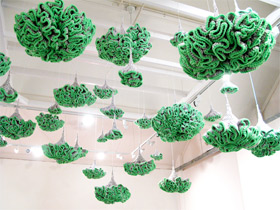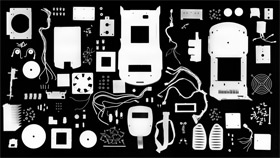

Chain Reaction
Sidney Cooper Gallery, Canterbury
22 November – 21 December 2013



Chain Reaction was a project exploring creative and scientific processes in response to the 30th anniversary of the invention of the Polymerase Chain Reaction (PCR). This reaction is routinely performed by a humble box on the lab bench, the PCR machine. Scientists use it every day but rarely stop to think about it; most of the rest of us have never even heard of it. Yet it is the unsung hero of the genetic revolution behind police forensics, disease diagnosis, paternity testing and the human genome project. As such PCR forms an unexpected route into the heart of how scientists actually work in their laboratories. Funded by the AHRC, six artists were invited to engage with scientists from the University of Kent's School of Biosciences to learn what the PCR machine does, how it works and the impact it has had on society.
I decided to explore the key concepts of ‘doubling’ and ‘copying’ implicit in PCR, to develop artwork that makes doubling and copying tangible in space and time, and so to reveal the contents of the ‘black box’ of the machine itself. The huge numbers generated in exponential doubling inspired me to search for a three-dimensional equivalent, finally resulting in the large scale chain-crochet installation Exponential. The stop-frame animations for Copy.copy are collaborative works, exploring ways of copying an image, like Chinese Whispers, incorporating inherent errors and mutations. The large photogram Sum of the Parts traces the components of a PCR machine, as a full-size homage portrait.
From an earlier career in Bioscience, it’s been a wonderful revelation to return to the lab as an artist, and to discover the dramatic advances in bench techniques and equipment. Parallels can be drawn between the scientist’s laboratory and the artist’s workshop as places of research, and of the exploration of exciting ideas for success or abandonment. Scientists and artists alike have constraints: the scientist is limited by research tools and equipment, and the need to produce testable results; the artist is limited by materials, formats, and the commissioned brief. Both rely on intuition, creativity, and the rational assessment of outcomes. And both use schemata in their work, for the required degree of accuracy or expression: conceptual imagery which is common to written language, the scientific diagram, and visual artwork.
